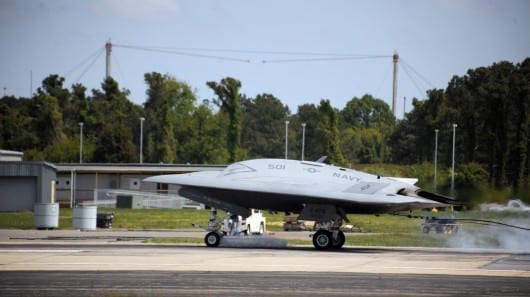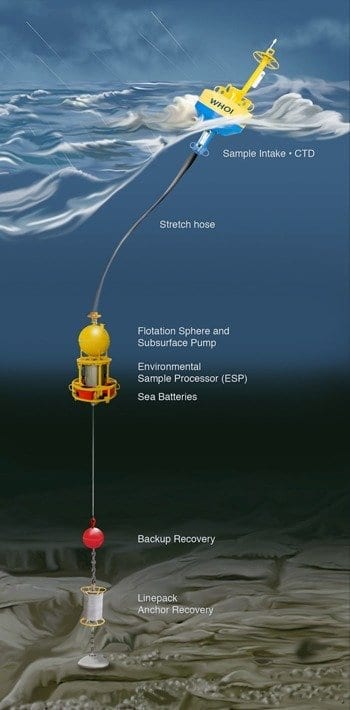
The robot apocalypse came a step closer as Northrop Grumman and the US Navy carried out a successful carrier-style landing of the X-47B Unmanned Combat Air System (UCAS) demonstrator.
The test, which was carried out on May 4 at the Naval Air Station Patuxent River in Maryland, used a land-based version of an aircraft carrier cable-arrested landing system as the beginning of the final phase of testing prior to carrier-based trials planned for later this month.
Landing on an aircraft carrier is one of the most hair-raising maneuvers a pilot can carry out. Even the most jaded has sweaty palms while guiding in a 60-million dollar aircraft at hundreds of miles an hour to land on a flight deck that looks about the size of a chocolate bar. Watching an autonomous unmanned aircraft try the same thing is almost as bad, but if combat UAVs like the X-47B are to become part of the fleets of the future, they’ll need to master the art so they don’t end up as piles of high tech scrap.
Saturday’s test was a cable-arrested landing, which is the technique that allows high-speed aircraft to land on a short carrier deck with relative safety. During landing, the aircraft deploys a landing hook that snags a heavy cable strung across the flight deck. As the cable plays out, it absorbs the energy of the plane and quickly brings it to a controlled stop. In the X-47B’s case, this system was set up on an airfield rather than an aircraft carrier, but the navigation approach was designed to simulate that of carrier operation.
The landing was the highlight of three three months of shore-based carrier testing , which included precision approaches, touch-and-go landings, and precision landings. Carl Johnson, vice president and Navy (UCAS Carrier Demonstration) UCAS program manager for Northrop Grumman said, “The X-47B air vehicle performs exactly as predicted by the modeling, simulation and surrogate testing we did early in the UCAS-D program. It takes off, flies and lands within a few feet of its predicted path.”
The Latest Bing News on:
Unmanned Combat Air System
- Russian air defenses destroy 193 Ukrainian UAVs, 3 smart bombson April 27, 2024 at 12:35 am
Moscow, SANA-Russian air defense forces shot down 193 Ukrainian unmanned aerial vehicles (UAVs), 2 rockets and 3 smart bombs over the past day, TASS quoted Russian Defense ministry as saying in a ...
- Collaborative Combat Aircraft: How the U.S. Navy and Air Force Could Be Transformedon April 26, 2024 at 7:31 am
Summary: The U.S. Air Force and Navy are collaborating on a "Collaborative Combat Aircraft" (CCA) initiative, focusing on developing unmanned aerial systems (UAS) to act as "loyal wingmen" to manned ...
- German, France sign deal in Paris on developing future weapons systemon April 26, 2024 at 2:58 am
The French and German defence ministers signed an agreement in Paris on Friday for a joint Franco-German led armaments project worth billions of euros, which includes the development of a ...
- Unmanned ground vehicles rapidly finding their place on battlefieldson April 25, 2024 at 11:27 am
G lobal militaries are increasingly building, deploying, and operating unmanned ground vehicles, or UGVs. Mykhalio Fedorov, Ukraine's Vice Prime Minister for Innovations, wrote on Twitter that, "I ...
- Air Force Advances Collaborative Combat Aircraft Program with Anduril and General Atomicson April 25, 2024 at 9:24 am
The Department of the Air Force has announced the continuation of its partnership with Anduril Industries and General Atomics Aeronautical Systems Inc., selecti ...
- Air Force Picks Anduril And General Atomics To Build And Test Collaborative Combat Aircrafton April 25, 2024 at 3:53 am
The U.S. Air Force has awarded the two companies the funding for detailed designs, manufacture, and testing of production representative test articles ...
- Air Force picks Anduril, General Atomics for next round of CCA workon April 24, 2024 at 3:42 pm
The two vendors emerged successful from an original pool of five and are expected to carry their drone designs through a prototyping phase that will build and test aircraft.
- Here are the two companies creating drone wingmen for the US Air Forceon April 24, 2024 at 2:55 pm
The decision marks the service’s most significant step yet as it aims to create a series of drones using autonomous software to fly alongside piloted jets.
- Ground Drones: The Next Frontier Of Unmanned Combat In Ukraineon April 18, 2024 at 8:28 am
Recent footage from Ukraine shows both Russia and Kyiv are using unmanned ground vehicles in combat. Here is why wheeled drones have proved the most difficult remote-controlled systems to develop.
- Unmanned Aerial Vehicleson January 14, 2024 at 4:00 pm
and remotely piloted aircraft systems (RPAS) of all kinds and sizes, including those used for intelligence, surveillance and reconnaissance (ISR), combat (unmanned combat air vehicles, or UCAVs ...
The Latest Google Headlines on:
Unmanned Combat Air System
[google_news title=”” keyword=”Unmanned Combat Air System” num_posts=”10″ blurb_length=”0″ show_thumb=”left”]
The Latest Bing News on:
Autonomous unmanned aircraft
- Will AI Fight Wars Autonomously in the Future? Or Are We Already There?on April 27, 2024 at 10:16 am
Artificial intelligence is expected to impact human life in every aspect of its existence, but the most concerning one that experts fear the most is its application in warfare, and they are not wrong ...
- China Green-Lights Mass Production of Autonomous Flying Taxison April 26, 2024 at 6:59 am
China green-lights mass production of autonomous flying taxis. EHang got its first certification and plans to release the first one in 2035.
- XPONENTIAL 2024 Opens With An Emphasis on Autonomous Military Techon April 25, 2024 at 8:20 am
Keynote Sets Tone for New Leadership AUVSI plans to launch “Robot Ready” Campaign in 2025. Michael Brasseur (USN Ret.), Chief Strategy Officer at Saab Inc., and Aaron Pierce, CEO of Pierce Aerospace, ...
- China green-lights mass production of autonomous flying taxis — with commercial flights set for 2025on April 25, 2024 at 4:00 am
The EHang EH216-S autonomous flying taxi is the first eVTOL ready for mass production and could lead the way for flying cars around the world.
- Air Force Picks Anduril And General Atomics To Build And Test Collaborative Combat Aircrafton April 25, 2024 at 3:53 am
The U.S. Air Force has awarded the two companies the funding for detailed designs, manufacture, and testing of production representative test articles ...
- Shinmaywa to develop unmanned amphibian to deploy autonomous subson April 24, 2024 at 7:59 pm
Shinmaywa has secured a Japanese government contract to research an unmanned amphibian that will serve as a mothership for autonomous unmanned vehicles (AUVs).
- Anduril moves ahead in Pentagon program to develop unmanned fighter jetson April 24, 2024 at 4:24 pm
including piloted aircraft (Boeing and Lockheed are still in the running for manned system contracts). At the center of Anduril’s victory is Fury, an autonomous air vehicle that it acquired when it ...
- Air Force passes on Boeing for drone contract. But overall defense unit revenue is up.on April 24, 2024 at 3:51 pm
CFO Brian West told analysts Wednesday that the defense unit's results took a $222 million hit from losses in two fixed-price development programs — $128 million in the KC-46 tanker program, and $94 ...
- Here are the two companies creating drone wingmen for the US Air Forceon April 24, 2024 at 2:55 pm
The decision marks the service’s most significant step yet as it aims to create a series of drones using autonomous software to fly alongside piloted jets.
- AeroVironment Launches New AI Capability and Autonomy Kit for Unmanned Systemson April 24, 2024 at 7:51 am
AeroVironment (AV) has introduced its Autonomy Retrofit Kit (ARK) and AVACORE software demonstrating the company’s commitment to advancing autonomy and machin ...
The Latest Google Headlines on:
Autonomous unmanned aircraft
[google_news title=”” keyword=”autonomous unmanned aircraft” num_posts=”10″ blurb_length=”0″ show_thumb=”left”]










